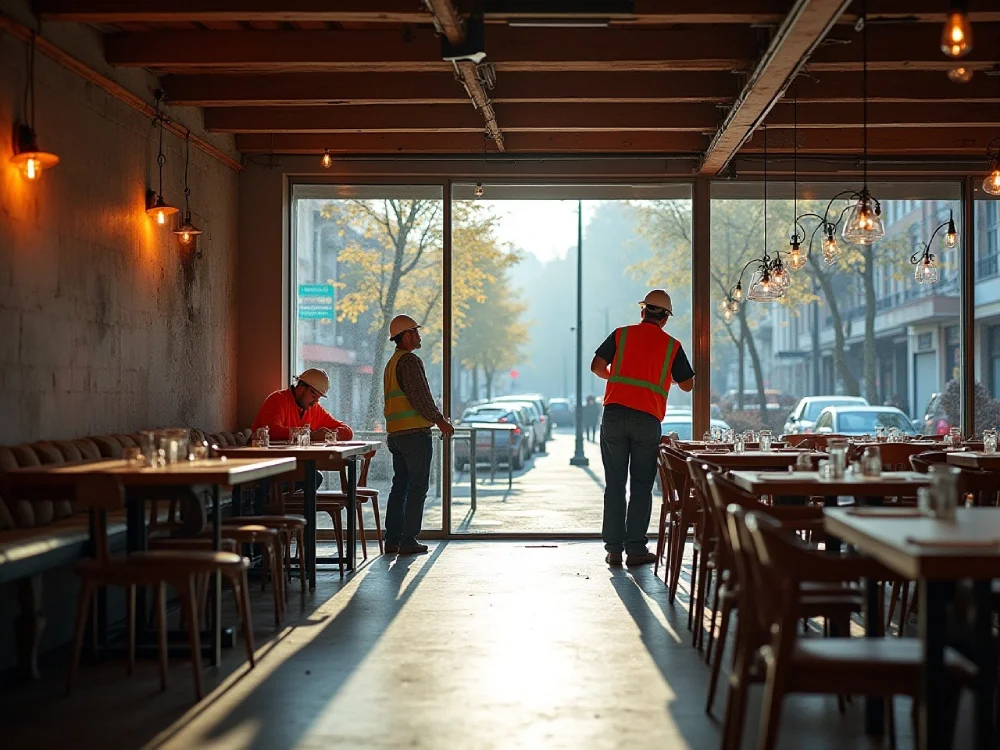
Modular construction is a factory-based building method that reduces restaurant and retail construction timelines by 30-75% while cutting labor costs by 40% through off-site assembly of prefabricated components.
Leading restaurant chains and retailers slash construction timelines by 50% using modular construction, a factory-based approach that transforms unpredictable building projects into streamlined operations. This method cuts labor costs by 40% while maintaining quality through climate-controlled manufacturing environments. Teams assemble components off-site, eliminating weather delays and reducing waste by 90%. The process enables rapid franchise expansion with consistent brand standards across locations. Explore how this proven strategy revolutionizes commercial construction below.
While competitors struggle with extended project timelines, forward-thinking construction companies are discovering powerful techniques that slash development schedules by up to 50 percent. The Modular Building Institute reports that industrialized building systems demonstrate exceptional results, reducing high-rise construction from 627.5 days to just 525.4 days through prefabricated components and ultra-efficient project staffing.
Companies implementing concurrent engineering run multiple project phases simultaneously, eliminating traditional sequential bottlenecks. According to the Construction Industry Institute, these methods can reduce project duration by 30-50% while maintaining quality standards.
Modular construction transforms unpredictable labor expenses into fixed, manageable costs that contractors can accurately forecast months in advance. Factory assembly environments reduce labor requirements by consolidating multiple trades into streamlined production lines, where workers complete repetitive tasks with maximum efficiency and minimal downtime.
| Construction Method | Labor Hours Required | Cost per Square Foot | Quality Control Rating |
| Traditional On-Site | 100% baseline | $45-65 | 85% |
| Modular Factory | 60% of baseline | $30-45 | 95% |
| Hybrid Approach | 75% of baseline | $38-55 | 90% |
The National Association of Home Builders reports that 80-90% of contractors struggle to find qualified workers in today's market. Modular construction offers a practical solution by requiring fewer on-site laborers while maintaining project quality and timelines.
Factory assembly environments eliminate weather delays, reduce on-site coordination challenges, and allow skilled workers to produce more units per hour than traditional construction methods permit.
Weather-related construction delays cost the industry billions annually according to the Associated General Contractors of America, but factory-built components eliminate this expensive problem entirely. Manufacturing facilities operate in climate-controlled environments where rain, snow, and extreme temperatures never interrupt production schedules.
This indoor approach transforms construction timelines, allowing projects to maintain steady progress throughout the year while traditional job sites shut down during storms. The McKinsey Global Institute reports that controlled factory settings enable quality control improvements of up to 75% compared to traditional construction methods.
Advanced machinery performs cutting, welding, and assembly operations without weather-related disruptions, while smaller, highly skilled teams achieve 62% value-adding activities compared to traditional construction.
Construction projects face a critical intersection where building permits and loan pre-approvals must align perfectly, yet many developers discover these two processes operate on completely different timelines. According to the International Code Council, standardized modular components often receive faster permit approvals due to pre-engineered designs.
Banks evaluate projects using "as is" and "as will be" values, helping developers understand their borrowing capacity before breaking ground. Since pre-approval letters remain valid for 60 to 90 days, timing becomes essential for project success.
Successful builders know that securing permits and financing represents only the beginning of creating profitable multi-location businesses. The International Franchise Association emphasizes that brand consistency drives customer loyalty and repeat business across franchise networks.
Smart construction teams integrate consistent branding elements from day one, installing uniform fixtures, signage, and layouts that transform random storefronts into recognizable destinations. Professional builders collaborate with brand managers to implement standardized service protocols through strategic facility design.
Forward-thinking contractors transform construction sites into environmental success stories by implementing waste reduction strategies that achieve astonishing 90% landfill avoidance rates. The U.S. Green Building Council reports that TRUE Zero Waste Certification programs examine comprehensive waste operations, creating structured plans that slash disposal costs while meeting challenging diversion goals.
| Strategy | Waste Reduction | Cost Savings | Implementation Time |
| Right-Sized Packaging | 25-35% | $2-4 per sq ft | 2-4 weeks |
| Recyclable Materials | 40-60% | $5-8 per sq ft | 4-6 weeks |
| Supplier Collaboration | 60-80% | $8-12 per sq ft | 6-8 weeks |
| Factory Pre-Assembly | 85-90% | $15-20 per sq ft | 8-12 weeks |
According to the Environmental Protection Agency, these waste recycling systems generate remarkable returns, with every dollar invested producing eight dollars in savings. Restaurant construction particularly benefits, as food costs represent 35% of sales, making waste prevention directly impact profitability.
Savvy entrepreneurs recognize franchise expansion as the fastest path to building multi-unit empires, with the International Franchise Association projecting the industry to add over 20,000 new establishments in 2025 alone.
| Growth Sector | Projected Growth | Revenue Impact |
| Personal Services | 4.3% growth | $42B increase |
| Retail Food | 3.5% growth | $38B increase |
| Fitness/Spa | 4.0% growth | $15B increase |
| Home Construction | 3.8% growth | $28B increase |
| Business Services | 2.9% growth | $31B increase |
The Southwest and Southeast regions offer prime expansion territories, projecting 8.5% and 6.2% output growth respectively according to Bureau of Labor Statistics data. With franchising outpacing overall economic growth at 2.5% versus 1.9%, smart operators capitalize on this proven model to multiply locations, revenue streams, and market dominance.
While traditional construction battles unpredictable weather and costly delays, climate-controlled manufacturing transforms the building process into a precise, predictable operation that eliminates common project pitfalls. Factory environments maintain consistent temperatures year-round, protecting materials from moisture damage and enabling workers to maintain steady productivity rates.
Indoor manufacturing eliminates seasonal construction limitations completely. Teams work efficiently in climate-controlled facilities, where optimized module installation schedules remain unaffected by rain, snow, or extreme temperatures.
Factory-built construction transforms how restaurants and retailers expand their footprints, offering significant competitive advantages through faster timelines, reduced costs, and predictable outcomes. This technology eliminates weather delays, streamlines permitting, and ensures brand consistency across locations while reducing construction waste by up to 90%. As construction labor shortages persist and environmental regulations tighten, modular construction provides a proven solution that delivers the speed, savings, and scalability essential for modern business growth.
Ready to revolutionize your next restaurant or retail construction project? Contact certified modular construction specialists today to discover how factory-built components can cut your timeline in half, reduce costs by 40%, and eliminate construction surprises. Your competition is still waiting for good weather – don't let them catch up.
When it comes to restaurant construction, modular methods can shorten schedules by 30–75%. This means restaurant owners can launch a new restaurant or complete a restaurant building project weeks or even months earlier than with traditional construction practices. Because site preparation and factory assembly happen at the same time, weather delays are virtually eliminated. Faster project completion allows operators to focus on their target audience, refine the dining experience, and begin generating revenue sooner.
Not at all. A restaurant construction project using modular techniques can fully support restaurant design choices, from kitchen layouts and seating arrangements to color schemes and architectural design. Modular systems provide flexibility for creating spaces that reflect a brand’s identity while maintaining service efficiency and operational efficiency. With careful planning, restaurant projects can integrate energy-efficient systems, advanced HVAC systems, LED lighting, and sustainable material use—all while enhancing the unique dining atmosphere your brand envisions.
Although quality materials may cost about the same, modular construction services typically save 20–40% on the overall budget. Reduced labor, faster schedules, and minimized downtime help avoid costly budget overruns and unforeseen expenses. In the restaurant industry, this predictable approach to costs supports project management efficiency and ensures restaurant owners stay within budget without sacrificing functionality and aesthetic appeal.
The construction process for modular projects often streamlines approvals because factory-built components are pre-engineered to meet or exceed local building codes and safety regulations. Obtaining the necessary permits can move faster since many jurisdictions recognize the consistency of standardized modular systems. By aligning with authorities early in the construction phase, modular builders help restaurant owners avoid potential issues while ensuring compliance with fire safety, waste management, and accessibility standards.
Yes. Modular techniques are highly effective for renovation of restaurant space or retail locations. Prefabricated components can be installed during off-hours, reducing disruption to daily operations. This approach helps keep your home away from business downtime and reduces renovation timelines by 40–60%. With well-planned modular methods, kitchen systems can be reconfigured, plumb and heating and cooling systems upgraded, and modern kitchen equipment installed. The result is an updated dining area that maximizes service efficiency while keeping the renovation project consistent with your brand and staying within budget.

Whether you’re remodeling a home, expanding a business, or starting from the ground up, TriStar Built is here to guide you every step of the way. With a focus on craftsmanship, communication, and results that last, we make the construction process clear, smooth, and worth every investment.

LOCATION: 2126 James Street, Denton, TX 76205
PHONE: (940) 381-2222
© 2025 TRISTAR BUILT - ALL RIGHTS RESERVED | WEB DESIGN & SEO BY: Authority Solutions®